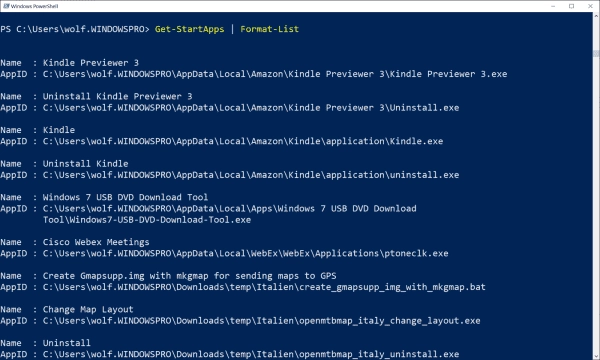Pinning important company applications isn’t the only reason for taskbar configuration. Often, it is also about removing the default icons that Microsoft pins.
In some cases, for reasons that remain unknown, certain elements are given a special status and can’t be manipulated by a standard taskbar. This is true for the new chat icon on Windows 11 and the search field. These can be adjusted separately via Group Policy.
Delivery of configuration through an XML file
The method for setting up and distributing taskbar configurations hasn’t fundamentally altered since Windows 10 was introduced. Nevertheless, the function to export an existing arrangement to an XML document through Export-StartLayout has been phased out. Now, the process demands manual creation. Microsoft supplies a pattern that encompasses sample entries for illustrating how to designate a program by its ID or path.
To view the appellation and IDs of software installed, this PowerShell command can be utilized:
Get-StartApps | Format-List
Microsoft distinguishes between UWP and Desktop Apps, incorporating them with the prefix <taskbar:UWA> for UWP and <taskbar:DesktopApp> for desktop software.
Display names and IDs of installed applications in PowerShell
Removing Default Apps
To remove default apps from the list, add the PinListPlacement attribute to the <CustomTaskbarLayoutCollection> element:
<CustomTaskbarLayoutCollection PinListPlacement="Replace">
Creating a “golden image” for all PCs
If an app specified in the XML file isn’t installed on the target computer, Windows still applies the file but doesn’t display the corresponding icon. This means you don’t need separate XML files for differently configured computers.
Once the file is saved with a suitable name, it can be distributed with Group Policies or Microsoft Intune.
Distributing the Taskbar with Group Policies
To distribute taskbar settings with group policies, provide the XML file on a share or copy it to Windows PCs using a login script. In a GPO, enter the path to the file under User Configuration => Policies => Administrative Templates => Start Menu and Taskbar. If you use a UNC path, user accounts must have read access to this share.
If Windows cannot find the file during login or cannot read it due to a lack of user rights, the taskbar remains at default settings, and users cannot change it.
Deploying Taskbar settings with Microsoft Intune
The XML file can also be deployed using Microsoft Intune. To do this, create a profile in the Intune Admin Center under Devices => Configuration => Policies.
In the new profile selection window, choose Windows 10 and later for the platform and Templates > Device restrictions for the profile type. Then, start the configuration of the new profile, naming it, for example, “Taskbar settings,” and specify the XML file on the Configuration settings page.
The taskbar configuration will apply to the target computers after assigning the configuration profile to the desired PCs.
